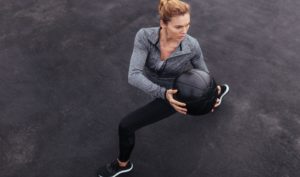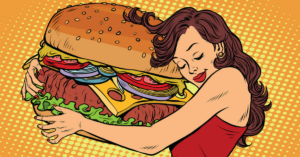Let’s face it, there are so many reasons for cutting weight, such as:
- Aiming to improve your health
- Improve your appearance
- Making a lower weight-class or getting on a bodybuilding stage
- Getting to a healthy weight
- Maybe even a vacation or photo shoot to look your best
Losing body fat and cutting weight is a common goal shared by many.
A 2014 article in the Journal of the International Society of Sports Nutrition reviewed the literature pertaining to metabolic consequences of dieting, with an emphasis on athletic populations.
This was a strong paper because it helps identify and acknowledge the difficulties and hurdles faced by dieters.
This evidence also can help practitioners and fitness enthusiasts identify solutions to these common metabolic consequences from cutting weight.
But to avoid these obstacles, we must acknowledge 5 real-world truths of weight loss.
(Side Note: Looking to get your individual macros? See the IIFYM flexible dieting calculator)
1. Your Metabolism Will Adapt During Calorie Restriction
When cutting weight, you lose body mass from muscle tissue, bone, water, etc. Naturally, you would expect that less overall tissue equals less demand for energy, and therefore a reduction in metabolic rate.
This is absolutely true, but with weight loss, the issue goes a bit deeper— metabolic rate often slows down beyond the amount we would expect from decreased body mass.
In the 2014 article in the Journal of the International Society of Sports Nutrition, a number of metabolic adaptations contribute to this reduction in energy expenditure (metabolic rate), such as:
- You see reductions in hormones related to metabolic rate, including thyroid hormone, insulin, and leptin
- The reduction in anabolic hormones and increase in catabolic hormones threaten the retention of lean mass
- You also see increased efficiency of energy production—When efficiency increases, we lose less of this energy in the conversion process. This means we can meet our demand for ATP by burning fewer calories, which serves to reduce metabolic rate and oppose our weight loss goals
The numerous metabolic adaptations to calorie restriction and cutting weight result in a clear response, a reduced metabolic rate.
This affects total daily energy expenditure which pertains to 4 compartments:
- Basal metabolic rate (calories burned during rest)
- Exercise activity thermogenesis (calories burned during formal exercise)
- NEAT- Non-Exercise Activity Thermogenesis (calories burned outside of formal exercise)
- TEF- Thermic effect of feeding (calories burned during digestion)
As you can see, the human body appears to fight perceived starvation by increasing its efficiency.
Unfortunately, many of the underlying adaptations persist after active weight loss is achieved and weight maintenance is underway.
When you impose an “energy crisis” by dieting, cutting weight, and losing body fat, these adaptations serve to reduce energy expenditure.
It’s the metabolic equivalent of tightening up your budget during tough financial times.
Take Home Point:
Understand that your metabolism will adapt during a long dieting phase, especially if you lose both muscle mass and fat mass. To mitigate this, take more frequent diet breaks, have 24-72 hour refeeds, lose weight slowly, have proper macronutrient ratios, and keep resistance training in.
2. Muscle Mass Will Be Lost
To be 100% honest and fair, this one doesn’t necessarily apply to everybody.
The reason being If you’re dieting from 30% body fat to 25%, you can probably do so with minimal loss of lean mass (muscle tissue) because a 5-pound difference won’t really sacrifice muscle mass.
Now, if you have been under-eating protein or had not been resistance training, you could even gain lean mass while losing fat (body recomposition) by increasing protein consumption and starting a properly-designed resistance training program.
But if you’re shooting for a stage-ready, competition-level body fat, the loss of lean mass is pretty much inevitable.
The data shows two different case studies have documented contest preparation in male natural bodybuilders.
Although both competitors were on well-designed diet and training programs, they lost 6.2 and 14.0 pounds of lean mass (pure muscle mass).
Realistically, a natural athlete will not likely approach 5-6% body fat without a loss of lean mass.
But in all honesty, the case studies previously mentioned could be considered quite encouraging.
One athlete lost 14.0 lbs of lean mass, but 36.9 lbs overall, meaning they lost 22.9 lbs of fat.
The other athlete lost only 6.2 lbs of lean mass while losing 30.8 lbs overall— nearly 80% of the total weight lost was fat!
So, while we must accept that natural athletes tend to lose some lean mass while dieting and cutting weight, we can certainly strive to push the proportion of fat loss up.
Take Home Point:
Understand that you will lose some muscle mass during a long dieting phase. To mitigate this, take more frequent diet breaks, have 24-72 hour refeeds, lose weight slowly about .5-2 pounds per week, have a high protein diet, keep cardio as minimal as possible, and keep resistance training in.
3. Your Hunger Levels Will Go Through the Roof
Insulin and leptin are both considered “anorexigenic” hormones. Put simply, these hormones relay the message that there is plenty of energy available, leading to increased satiety and decreased hunger.
On the contrary, ghrelin is considered an “orexigenic” hormone; ghrelin rises just prior to meals, and it functions to stimulate hunger and food intake.
Leptin is released from fat cells, and smaller fat cells are more sensitive to insulin.
In the context of cutting weight, fat cells shrink in size. Accordingly, studies have shown that weight loss diets result in decreased leptin and insulin, along with increased ghrelin.
When the diet is “over,” the individual is left with a repressed metabolic rate, and an overwhelming desire to eat.
On top of these endocrine effects, there are a number of adaptations within the brain, along with psychological factors of dieting, that increase the desire to eat.
Truth is, there are some hard gainers out there that are so sick of force-feeding that they welcome the idea of decreased food intake. But for the overwhelming majority of dieters, hunger is an unavoidable real-world truth, especially as body fat gets significantly low, overall total daily calories reduce, and total daily energy expenditure decreases.
This is where proper macronutrient ratios, having a higher protein intake, and a sound resistance training program comes into play.
Take Home Point:
Understand that you will get hungry during a long dieting phase. To mitigate this, take more frequent diet breaks, have more frequent refeeds, experiment with mini carb ups when hunger is extremely high, eat satiating foods, and try having a glass of water and a salad prior to your main meals, at least 2 of your daily meals.
4. Maintaining Lost Weight Isn’t the Easiest Thing to Do
Let’s say you weigh 190 lbs. If you can drop to 171 lbs and maintain that weight for one year, you are fairly exceptional— less than 20% of individuals are able to lose 10% of their body weight and maintain that weight loss for one year.
In a real-world setting, cutting weight is not the hard part. Countless studies have successfully induced weight loss with all kinds of diet and exercise programs. But when you shift your focus from the 10-week studies to those lasting 6 months, 12 months, or beyond, you start to see that maintaining weight loss is a much more difficult task.
We previously discussed that metabolic rate is generally reduced in response to weight loss and reduced caloric intake.
Unfortunately, many of the underlying adaptations persist after active weight loss is achieved and weight maintenance is underway.
This means that even though you think you’re “done” cutting weight, we still see the following issues:
- a repressed metabolic rate
- altered hormone concentrations
- increased hunger and desire to eat
While some of these adaptations may subside after prolonged, successful weight maintenance, evidence has suggested that some may persist for over a year after weight loss.
The presence of these adaptations set the dieter up for a phenomenon known as “post-starvation obesity,” “body fat overshooting,” or in laymen terms “rebounding.”
When the diet is “over,” the individual is left with a repressed metabolic rate, and an overwhelming desire to eat.
This combination can result in huge caloric intakes that lead to rapid fat gain.
There is also evidence that weight is preferentially gained as fat mass (body fat) in this post-diet period, and we are particularly susceptible to adipocyte hyperplasia (the addition of entirely new fat cells).
These factors may lead to body fat overshooting, where the dieter actually ends up with more fat mass (body fat) than they had before the diet.
Take Home Point:
Understand that maintaining lost weight isn’t the easiest thing to achieve. To help keep the weight off, have proper macronutrient ratios, keep resistance training in, don’t fall into the rigid black and white mindset, and take a long break from dieting.
5. Your Mind Will Play Games with You
Out of the 5 real-world truths to dieting, this one has to be one of the hardest ones to overcome.
The reason being if you were cutting weight and losing body fat, let’s say you lost 20-40 pounds, and you retained some decent muscle mass, and completely changed your physical appearance.
Chances are you are going to want to stay with this look year around or perhaps push the needle and get leaner.
The problem is, after cutting weight, dieting, losing body fat, and metabolic adaptations occur, your body needs a break, or it may even need to put on some body fat to reverse some of the metabolic adaptations such as a suppressed metabolism, increased hunger, and shot hormonal profiles.
Your mind will play games and want you to stay at that level of leanness or push it to be leaner.
Your mind will play games when you look at your old progress pictures or when you go down the Instagram feed.
Your mind will play games with you when you hear your friends are hitting the stage or dieting and cutting weight for a vacation.
First, you need to be educated on that your body needs a break after dieting.
Two, it’s okay to put on some body fat and not be shredded year around.
And three, a strong support system and environment to help mitigate these games your mind will play.
Take Home Point:
Understand that your mind will play games with you. To mitigate this, understand your social and environmental surroundings, enjoy other activities in life, and acquire the mindset that fitness is a long-term journey.
Conclusion
Cutting weight and weight maintenance are no walk in the park, but you probably figured that out by the alarming prevalence of obesity, and the small number of bodybuilders achieving truly exceptional conditioning.
When losing weight, you’ll run into some obstacles that make the process a bit challenging.
But, by understanding these 5 real-world truths of weight loss, employing some effective training and nutrition strategies, and surrounding yourself with a strong support system and environment, you can attenuate these challenges and set yourself up for success for a long-term, joyful, and results driven fitness journey.
The post 5 Real World Truths of Weight Loss appeared first on IIFYM.
from IIFYM Recipes and Articles – IIFYM http://ift.tt/2BYmYC7







